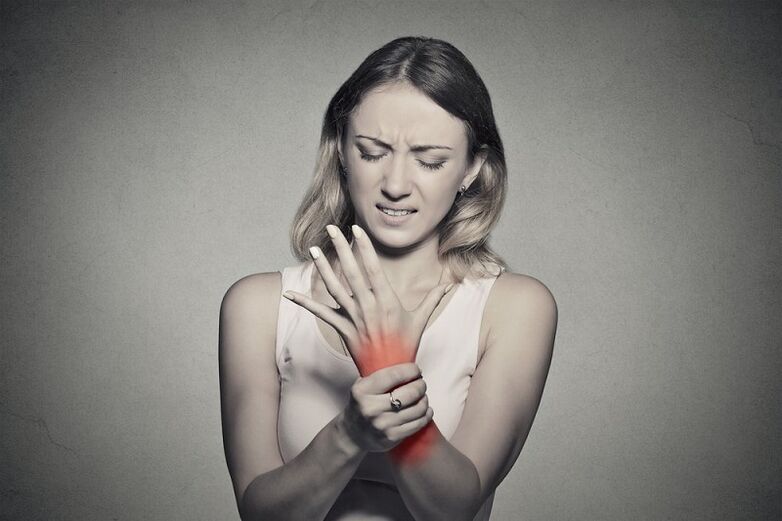Arthropathy is common and ranks third among the most common diseases, after cancer and cardiovascular disease.The disease affects men and women equally.About 20% of adults have this condition.The likelihood of developing joint disease increases with age.
Arthropathy is considered a chronic joint pathology in which a progressive process of destruction of cartilage and joint capsule occurs.If joint treatment is neglected, the bones themselves may become deformed and destroyed.
When the metabolic processes of the joints are disrupted, the cartilage loses its elasticity, eventually leading to joint disease.There are many reasons for the destruction of cartilage: overload, injury, genetic factors, hormonal changes, old age, metabolic disorders, insufficient blood circulation in the joints and some diseases.
There are two types of arthropathy: primary or secondary.In primary arthropathy, the recovery process of cartilage tissue is disrupted without any other abnormalities being detected in the body.Secondary arthropathy always occurs in damaged joints or as a result of other pathology in the body.
The progressive destruction of cartilage tissue causes pain and limited movement in the affected joint.Without adequate treatment, over time arthrosis of a joint can lead to complete loss of movement of the joint.
Causes of Arthropathy
When a joint's metabolic processes are disrupted or lubricant production is insufficient, the affected joint will suffer from poor gliding.As sliding properties deteriorate and loads increase and become excessive, irreversible damage processes occur in the joints.
Arthritis of the joints can be promoted by genetic diseases, mechanical damage in the form of fractures or various joint injuries.Obesity can also lead to the development of arthropathy by overloading the joints and, accordingly, joint damage.
Incorrect posture or surgical intervention can also have a negative impact on the joint, which can damage the joint's structure.
Insufficient calcium and trace elements, vitamin deficiencies, and metabolic disorders can lead to irreversible changes in bone tissue, cartilage, and lubricants.All these changes gradually lead to the interruption of the joint regeneration process and its further destruction.
Autoimmune diseases, estrogen deficiency, and hormonal disorders that occur in women during menopause can lead to changes in joint tissue and its destruction.
Other causes of joint disease include:
- disruption of blood supply to tissues;
- Decreased collagen synthesis (liver insufficiency);
- various inflammatory processes;
- Tissue nutrient deficiency;
- low temperature;
- Deterioration of metabolic processes in the body.
Symptoms of Arthropathy

Depending on the location of the lesion, the stage of the disease, the changes and extent of the process, the symptoms of the disease may vary:
- joint pain;
- Stiffness in the morning (or after rest);
- performance degradation;
- limp;
- Making a crunching sound when walking;
- restricted activities;
- Immobility of joints;
- Deformed joints in diseased joints;
- Inflammation of the affected joint;
- increased sensitivity to atmospheric changes;
- Muscle atrophy around joints.
Treatment of Arthropathy
Treatment of joint disease is divided into several stages:
- reduce pain,
- Reduce inflammation,
- Enhances the regeneration process of cartilage tissue.
Any load on the affected joints, prolonged walking or standing, or heavy lifting are contraindicated.
Treatment of arthropathy is a series of measures that help improve collagen production, restore metabolic processes, eliminate inflammation, activate blood circulation and nutrition in tissues.
During the treatment of joint disease, medications, physical therapy procedures and a balanced diet are required.In order to restore damaged cartilage and improve the composition of intra-articular lubrication, it is recommended to use chondroprotectants.
Treatment is prescribed individually based on the diagnosis, after conducting some studies to evaluate the condition of the tissues and structures surrounding the joint and to determine the degree of destruction of the cartilage tissue.
To improve blood circulation and condition of joint tissues, acupressure and acupuncture are recommended.
You can also perform moxibustion (cauterization) to relieve pain.This procedure involves using moxa (absinthe or charcoal cigar) to heat biologically active points on the body.Moxibustion therapy ensures blood flow and good tissue heating, improving metabolic processes.
Proper and balanced nutrition and physical therapy are important to improve the condition.
Complications of Arthropathy

If joint disease is left untreated, the disease progresses, causing an irreversible process over time that causes inflammation and deformation of bone or cartilage tissue.Deformation of the diseased joint can lead to reduced movement function or even complete immobilization (joint stiffness).
Complications of Arthropathy:
- Stiff movements;
- The joint is deformed or damaged.
Patients are at increased risk for disability and worsening of quality of life due to joint complications.
Dietary nutrition for joint disease
Since excess weight can lead to the development of joint disease, it is necessary to lose weight.Therefore, it is recommended to exclude pasta and sweets from the diet; you should also not drink alcohol and eat fatty fish.
To restore the strength of bones and cartilage, mobility of joints and elasticity of tissues, it is recommended to consume aspic - a treasure trove of trace elements and collagen.
To improve metabolism, it is recommended to include in the menu foods rich in B vitamins and folic acid.For joint diseases, mushrooms, eggs, dairy products and liver are very useful.
The nutritional principles for joint disease should be:
- Share meals;
- eliminate greasy foods (especially in the evening);
- Take daily walks in the fresh air;
- Constant weight control.


















